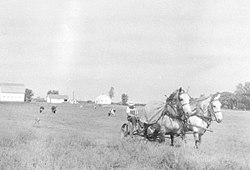
The earliest Anabaptism movement was a confession of faith in 1527.[1] Swiss brethren began the movement.[2] The movement was initiated by Menno Simons, a Catholic priest from Friesland (The Netherlands) who converted to Anabaptism.[3] He was against violence and introduced the practice of pacifism.[2] This was the beginning of the Mennonite movement. [4]
Research your ancestors on MyHeritage
Persecution and migration of MennonitesPersecution and migration of Mennonites
Many Anabaptists poured into Munster, Germany in 1534 and 1535. Some had gained control of the city and called other Anabaptists to join them. The leaders made bizarre laws they claimed to have received through revelation. An expelled Catholic bishop returned with an army to lay siege to the city.[3]
Anabaptists, including Mennonites, faced persecution from both Catholics and Protestants. Early Mennonites survived persecution by fleeing into neighboring states. They were safer where the ruling families were tolerant of their beliefs. Mennonites believed in peace. Fleeing was preferred over fighting, even in self-defense. Officials killed many leaders. In the sixteenth century, a group of Mennonites was forced to flee from the Netherlands to the Vistula River area in what is now northern Poland.[2] Persecutions in Switzerland continued into the eighteenth century, driving many Mennonites to Southern Germany, Alsace, the Netherlands, and the United States (or British Colonies).[2]
Migration of Mennonites to North AmericaMigration of Mennonites to North America

Mennonites began migrating to North America beginning in 1663. There, they enjoyed more freedom than their European counterparts.[4] In the American Colonies, Mennonites could preserve the faith of their fathers, seek economic opportunity and adventure, and escape European military conscription. [2]
In the 1710s, Mennonites came from Germany to Pennsylvania.[5] Under the rule of Catherine the Great (1762 to 1796), Mennonites went to Russia then moved on to Canada.[6] Many Mennonites left the Vistula delta in 1788 and went to the southern regions of the Russian Empire (now Ukraine), where they could acquire land and escape military conscription.[2]
Migration of Mennonites to Eastern EuropeMigration of Mennonites to Eastern Europe
Several groups of Mennonites left Switzerland. Some went to Russia, where they settled among Lutheran Germans, forming the Volga German community, before coming to America. Others travelled down the Rhine to Holland. Some went to England and some went to the United States.[7]
A group of Mennonites in Russia had a spiritual awakening in the 1860s. They founded the Mennonite Brethren Church and demanded stricter discipline for church members. Some of them left Russia after loving military exemption in the 1870s. They settled in the Midwestern United States and Manitoba, Canada.[2]
Migration of Mennonites to South AmericaMigration of Mennonites to South America

Mennonite migrations continuing in the twentieth century were primarily those leaving Russia for North and South America. They went to Brazil, Paraguay, Uruguay, Bolivia, Mexico, and British Honduras. Mennonites from North America and Europe established churches in Latin America, Africa, Oceania, India, and other parts of Asia.[2] Following the end of World War I and World War II, many Mennonites have emigrated from Russia to Germany.[2]
Mennonites in XX Century North AmericaMennonites in XX Century North America
One of the largest populations of Mennonites in the United States is in Lancaster County, Pennsylvania.[7] The largest Mennonite populations are in Canada, the Democratic Republic of the Congo, Ethiopia, India, and the United States. Additionally, there are Mennonite settlements in Argentina, Belize, Bolivia, Brazil, Mexico, Peru, Uruguay, Paraguay, and Colombia.[2]
The Mennonite diaspora retained their German language. This was in part due to its religious significance. It also served to insulate themselves against their social environment.[2]
See alsoSee also
Explore more about Mennonite emigration to the United StatesExplore more about Mennonite emigration to the United States
- Germans Immigrating to the United States record collection at MyHeritage
- Plain Folk: Researching Amish and Mennonite Families webinar at Legacy Family Tree Webinars
References
- ↑ Anabaptism. (2025, January 15). In Wikipedia. https://en.wikipedia.org/wiki/Anabaptism
- ↑ 2.00 2.01 2.02 2.03 2.04 2.05 2.06 2.07 2.08 2.09 2.10 Britannica , Britannica, online encyclopedia (https://www.britannica.com/topic/Mennonite : accessed 16 January 2025), Mennonite.
- ↑ 3.0 3.1 Jean Kilheffer Hess, Active Peacemaking, Mennonite Life, 31 August 2021, viewed 16 January 2025, <https://mennonitelife.org/mennonite-ways/>.
- ↑ 4.0 4.1 Mennonites. (2025, January 12). In Wikipedia. https://en.wikipedia.org/wiki/Mennonites
- ↑ Peggy Clemens Lauritzen, “Plain Folk: Researching Amish and Mennonite Families,” video, uploaded 10 April 2019; Legacy Family Tree Webinars (https://familytreewebinars.com/webinar/plain-folk-researching-amish-and-mennonite-families/ : accessed 16 January 2025).
- ↑ Peggy Clemens Lauritzen, “Plain Folk: Researching Amish and Mennonite Families,” video, uploaded 10 April 2019; Legacy Family Tree Webinars (https://familytreewebinars.com/webinar/plain-folk-researching-amish-and-mennonite-families/ : accessed 16 January 2025).
- ↑ 7.0 7.1 FamilySearch, FamilySearch Wiki, research wiki (https://www.familysearch.org/en/wiki/Mennonites : accessed 16 January 2025), Mennonites.

